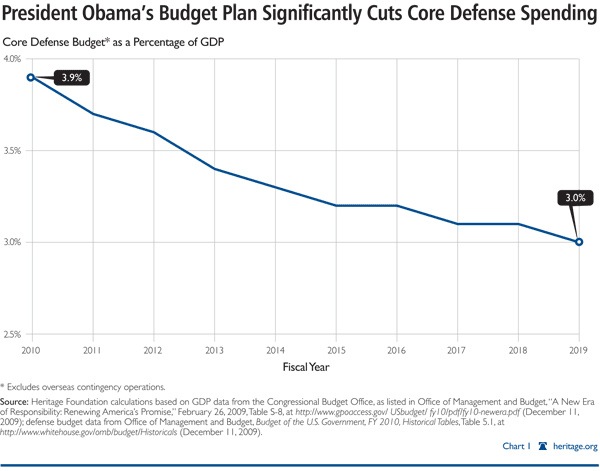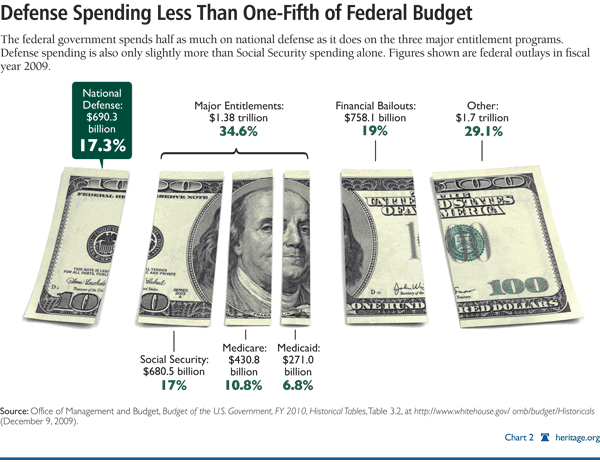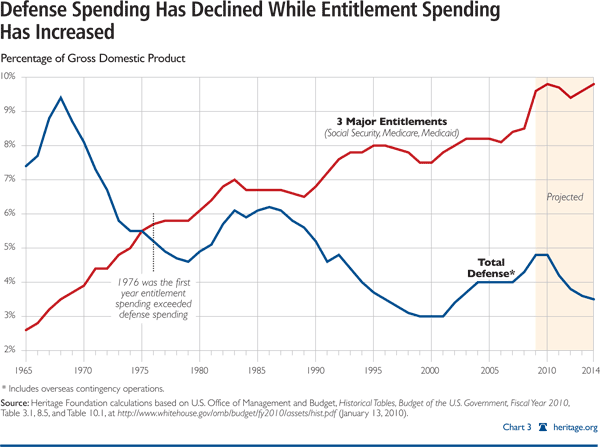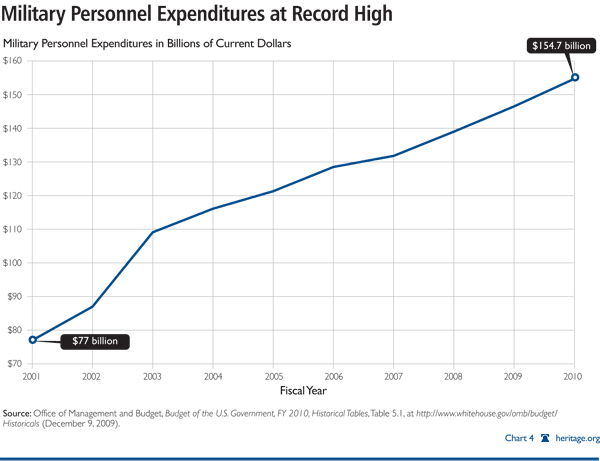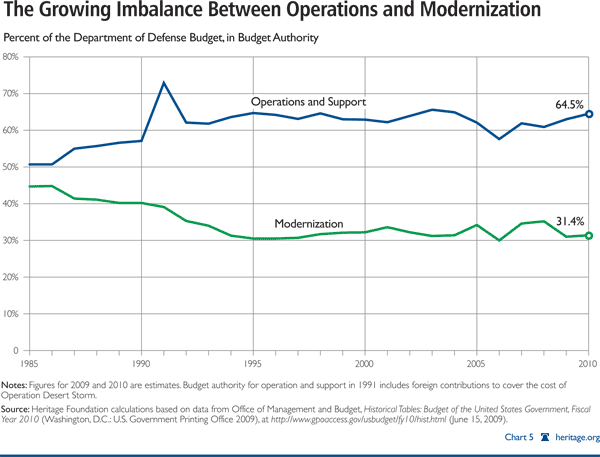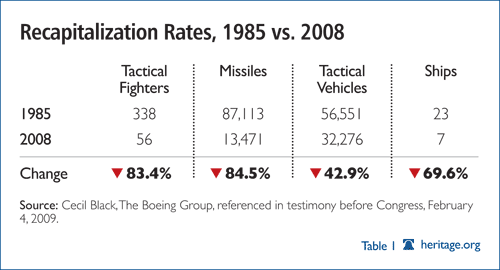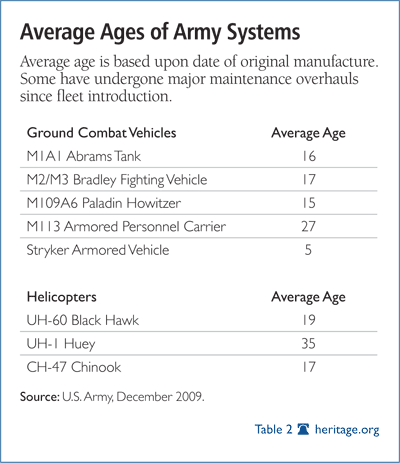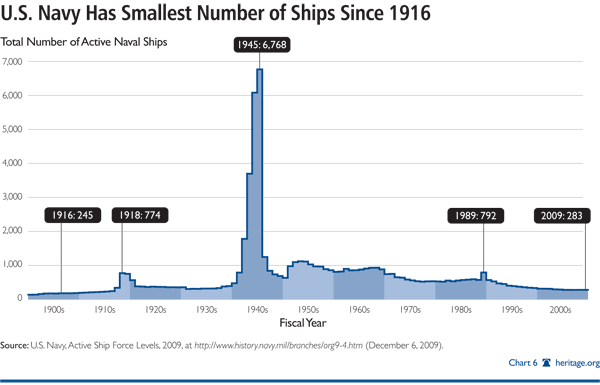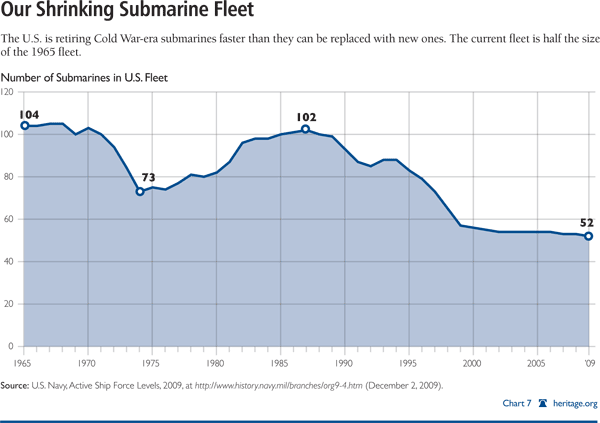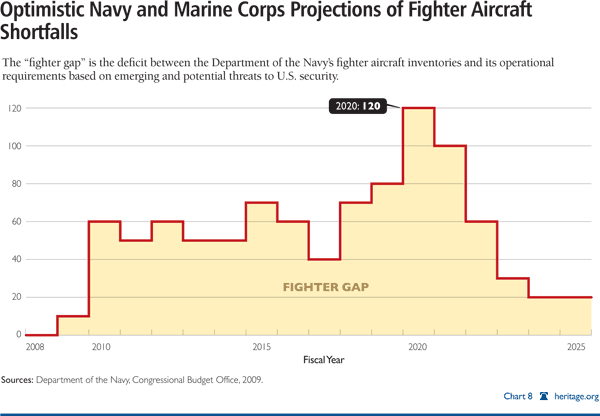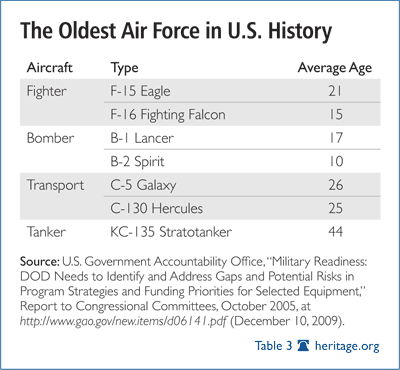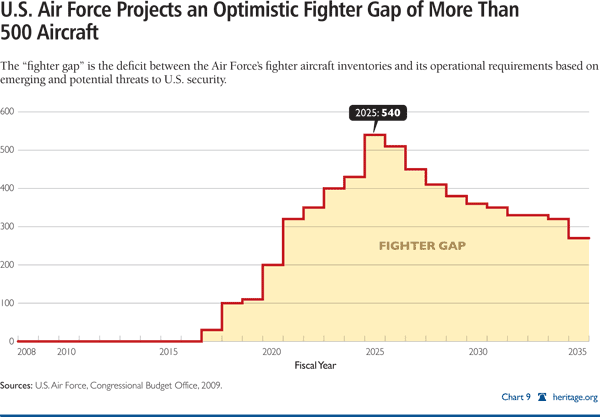Overview
The U.S. government’s primary job is to provide for the common defense. The most important element to protecting vital national interests is the U.S. military, which reinforces America’s diplomatic initiatives, acts to deter threats, and, when necessary, fights and wins the nation’s wars.
Two primary components determine a strong military: the quality of its servicemembers, and the modern, technologically advanced equipment available to them.
After nearly a decade of continuous warfare—and coming off a previous decade of underinvestment in next-generation equipment and systems in the 1990s and dramatically reduced force levels—America’s military personnel remain exceptional but are stressed, experiencing reduced readiness levels and lacking diverse training. The military’s equipment is old and getting older in part because it is employed at breakneck wartime rates.
The range of potential missions facing today’s military is vast. While winning the wars in Iraq and Afghanistan remains a central mission, regional combatant commanders must also respond to humanitarian disasters, protect sea lines of communication and free trade, deter rogue states through a credible extended deterrence posture, and hedge against the future uncertainty that accompanies the rise of powers like China and Russia.
Regrettably, the tools required to sustain all of these efforts are in jeopardy. The collective decisions by Congress and both Democratic and Republican Presidents over the past 15 years have left the U.S. military using equipment that is extremely old and, in many cases, outdated. The average ages of major platforms today include:
- Air Force tactical aircraft: over 20 years old;
- Navy and Marine Corps tactical aircraft: over 15 years old;
- Army M-113 armored personnel carriers: 27 years old;
- Bradley fighting vehicles: 17 years old;
- CH-47 Chinook helicopters: nearly 20 years old;
- UH-1 Huey helicopters: 35 years old;
- Ticonderoga-class cruisers: nearly 20 years old;
- P-3C Orion long-range aircraft: almost 25 years old;
- B-1 Lancer bomber: over 20 years old;
- C-5A Galaxy transport aircraft: 40 years old; and
- KC-135 tankers: 44 years old.
While compensation for military personnel continues to rise necessarily and deservedly, defense investment in modern systems to replace the vast arsenal of the military’s high-end platforms, like ships, planes, and tanks, is falling. Not only is investment in modern equipment declining, but the military in general has been buying less for the past 15 years.
After the Cold War ended, the Clinton Administration believed an era of peace was at hand. Consequently, the President and Congress cut both the size of the military and the funding for modernization far below what was necessary to sustain American capabilities.
While President George W. Bush increased spending on the military, it was not enough to remedy the shortfalls of the 1990s, particularly with ongoing operations overseas since 2001. As a result, the military’s capital inventory has become largely outdated.
The impact of collective decisions made over the past 15 years and the operations tempo of U.S. forces abroad means that today America is in danger of losing vital core security capabilities without increased investment. This includes the potential loss of core defense capabilities such as air dominance, maritime control, space control, and projecting power to distant regions.
Short-Term Readiness and Long-Term Superiority at Risk
- Under the Obama Administration’s long-term budget projections, the core defense budget will steadily decline in real dollar terms and as a share of the economy (U.S. gross domestic product or GDP) from an already low base of 3.9 percent in 2009 to just 3.0 percent in 2019.[1]
- Contrary to popular perception, just 17.3 percent, or less than one-fifth, of federal spending went to national defense in 2009.[2] By historical standards, the federal government’s investment in defense is relatively modest, particularly in wartime given that the military is heavily engaged in ongoing operations in Iraq and Afghanistan.
- Between 1990 and 2001, defense and homeland security spending was cut by $100 billion on average each year. Even though overall defense spending has grown 81 percent in real terms since its trough in 2001 before 9/11, it is still responsible for less than 20 percent of all new federal spending over that period.[3]
- Historically, the U.S. has borne much higher national security burdens. Defense spending was 38 percent of GDP during World War II, 14 percent during the war in Korea, 10 percent during the Vietnam war, and 6 percent during the Cold War. Since 2001, defense spending has averaged roughly 4 percent of the U.S. economy. In addition, the U.S. spends less on national defense than the total amount it spends on alcoholic beverages, tobacco, cosmetics and similar products, entertainment, and restaurants.[4]
- The defense budget is set to decline even though there remains a significant shortfall in military spending. According to the nonpartisan Congressional Budget Office, carrying out the President’s defense plans as laid out in the 2010 budget request would “require sustaining annual defense funding over the long term at higher real levels than those that occurred at the peak of the [Reagan] buildup in the mid-1980s.”[5]
Domestic Spending Exploding While Long-Term Defense Spending Falling
- Since the end of the Cold War, mandatory spending on major entitlements like Social Security, Medicare, and Medicaid has consistently claimed a far larger portion of the federal budget than defense has claimed. Growth in defense spending has been relatively constrained for the past two decades despite expanding missions for those in uniform and growing U.S. security commitments. In contrast, overall federal spending increased dramatically by 32 percent in 2009.[6]
- President Obama’s budget will grow permanent “base” federal spending 43 percent faster than inflation. This does not even include the cost of the President’s health care plan, which his last budget excluded from its spending and revenue totals.[7]
- In total, entitlements account for 65 percent of all federal spending and a record 18 percent of GDP.[8] The three largest entitlements—Social Security, Medicare, and Medicaid—eclipsed defense spending in 1975 and are projected to leap from 8.4 percent of GDP in 2007 to 18.6 percent by 2050. Beyond the Big 3, education spending has doubled since 2001.[9]
- Social Security grew by 10.7 percent, or a staggering $66 billion in 2009: from $617 billion to $683 billion. The growth in Social Security last year was larger than the $51 billion total cost of the war in Afghanistan in 2009.
The Composition of Defense Spending
- Compensation per military person has increased steadily since the end of the Cold War. For the past two decades, defense budgets have favored the military pay account over the procurement account (which buys modern weapons systems and equipment) with the exception of a brief spike in procurement associated with the surge in Iraq. Since September 11, 2001, both the military pay and procurement accounts have increased. However, the military pay account has increased more steadily and is on track to outpace procurement in the future.
- Military personnel costs are rising at an unsustainable rate and increasing pressure on other important accounts, such as modernization. Between 1999 and 2005, Congress increased pay for enlisted personnel by 28 percent and added hefty pension benefits and health care entitlements.
- At 64.5 percent of the defense budget, spending on operations and support—which includes the military personnel account and the operation and maintenance account—has grown to more than double the spending on military modernization. The imbalance stems in large measure from the growth in the cost of compensating military personnel (which is reflected in both the military personnel account and the operation and maintenance account that covers many health care costs).
- In many ways, the exploding costs of military health care and deferred benefits is a microcosm of the larger national debate about the Big 3 entitlements and the U.S. health care system in need of reform. The Congressional Budget Office estimates that the portion of the defense budget comprising medical funding will increase by 77 percent, from $39 billion in 2008 to $68 billion in 2025—and potentially more than double to $80 billion, taking unbudgeted costs into account.[10]
- Historically, defense modernization—the defense accounts that fund research, development and construction of equipment and platforms—has comprised about one-third of defense spending. In 2009, the portion of the defense budget devoted to modernization was just over 30 percent, which is at the low end of the range historically. By contrast, modernization spending was 44 percent of the defense budget in 1985.[11] Ironically, the vast majority of major systems the military uses today are those built in the 1980s and in need of replacement.
- Due to declining military modernization funds, recapitalization rates are falling dramatically. Whereas 338 tactical fighter jets were built in 1985, for example, just 56 were built in 2008. The rate of replacement for ships, tactical vehicles, and strategic systems has also fallen significantly.
Declining Capabilities
- The U.S. military today has a smaller number of ground combat vehicles, ships, and aircraft than at almost any other time in its history.[12]
- Many high-end military platforms are reaching the end of their service lifespans and are being retired faster than they can be replaced. The result is a widening capabilities gap and a higher level of operational risk for those in uniform.
- The Administration’s 2010 defense budget cancels or truncates many important military programs without presenting alternatives to fill the gap and in the absence of any formal foreign policy guidance. Examples include:
- F-22 fifth-generation fighter aircraft;
- Combat search and rescue helicopter;
- C-17 cargo airlifter; and
- Next-generation bomber.
- The President’s budget request also reduces funding for missile defense to $1.4 billion less than the amount provided in 2009.[13]
- The U.S. has only one fighter and one bomber production line open today. Yet Russia and China currently operate 12 of these production lines right now.[14] America’s shipbuilding industrial base is also under strain as budget requests change from year to year, and the planned number of ships to be built is repeatedly reduced and the schedule stretched further out into the future.
- Many major platforms are aging and exceed the military services’ guidelines for their useful life before they are retired. During wartime, aging is accelerated by wear and tear, imposing a far higher maintenance burden. For example, $17 billion worth of trucks, tanks, Humvees, and other equipment are lost each year in Iraq and Afghanistan, as opposed to $2.5 billion during peacetime.[15]
Restoring Military Readiness
- Congress must provide significant funding both for the restoration of short-term readiness levels and plans to build and maintain robust military capabilities over the long-term for an uncertain future.
- Congress should take steps to provide immediate relief to a force under stress. The proper planning and prioritization of maintenance on the military’s major platforms is required to ensure that the service lives of equipment being used at wartime rates are extended until replacements are available. Further growth in Reserve Component endstrength is also required to relieve strain on the National Guard and Reservists to enable them to respond to disasters at home and fight wars abroad.
- Congress should take special care to provide what is necessary to prevail in current combat operations while planning and building for the future. Defense spending should be sustained at today’s levels for three years after major operations in Iraq and Afghanistan subside in order to reset and modernize the force.
- Sustained, predictable defense investment is also needed to restore the quality and comprehensiveness of military training, which has been compromised by the heavy requirements of wartime deployments.
The State of the Army
The 1.1 million men and women serving in the active Army, Guard, and Reserves have repeatedly demonstrated their mettle and shown why America’s military is truly the best-trained, best-led in the world. Army soldiers—along with their counterpart Navy sailors, Air Force airmen, and U.S. Marines—have been fighting the longest war since America first created its all-volunteer force and the third longest war in U.S. history. Fighting and winning today’s wars while preparing for the future is a tremendous task that the nation has asked the Army to achieve.
Army leaders often speak of the need to restore the service to a state of balance where troop dwell time at home is extended, training is expanded beyond counterinsurgency missions, and the Army possesses the modern, dual-use equipment to respond to all types of contingencies, whether conventional conflict or domestic emergency response in support of civil authorities, and everything in between.
Current Readiness and Future Preparedness at Risk
- The Army’s 2009 posture statement acknowledges that “after seven years of continuous combat, our Army remains out of balance, straining our ability to sustain the all-volunteer force and maintain strategic depth.” Army leaders believe it will take “several challenging years ahead” to restore balance and set favorable conditions for the future.
- Due to current wartime operational demands for soldiers and insufficient time between deployments, the Army has had to focus unilaterally on counterinsurgency training and on a narrow range of weapons and equipment to the detriment of preparing for the full range of military missions across the spectrum of conflict.
- All Army combat brigades currently in the United States or preparing to deploy are rated as not ready. Many lack vital capabilities due to old age, attrition levels, and wartime losses of equipment; long maintenance backlogs; and need for cross-leveling of equipment between units.
- Although the Army is currently meeting high recruiting and retention goals, it is experiencing difficulty in keeping some of the best and the brightest, and its leaders acknowledge the current demand for forces exceeds “sustainable supply.” In 2007, the Army was short about 3,000 mid-career officers, and as a result, it was promoting captains and majors at rates well above its own guidelines.[16]
- Army personnel and their families have endured repeated deployments due to the high operations tempo in Iraq and Afghanistan. In 2007 and 2008, many servicemembers conducted 15-month tours with only 12 months rest at home.[17] The Army was able to ease strain on soldiers and their families in 2009 by reducing deployment times from 15 to 12 months but is still not offering enough time at home for reset and training.
- Strain on the U.S. Army has affected the National Guard and Reserves, reducing their preparedness for the full range of missions and ability to respond to disasters at home. On average, states and governors have less than half of their Guard equipment on hand to respond to crises, such as hurricanes, floods, and wildfires.
Aging Combat Equipment Getting Older with Wartime Wear and Tear
- The Army’s combat vehicle fleet of Abrams tanks, Bradley fighting vehicles, M113 personnel carrier-style vehicles, and self-propelled howitzers are old and getting older. M113-based vehicles were introduced in the 1960s. The Abrams tanks and Bradley fighting vehicles are largely based on technology from the 1980s.
- Many of the Army’s current combat vehicles will significantly exceed the Army’s guidelines before they are retired unless the Pentagon makes significant investments in upgrades or modifications.[18]
- Annual purchases of Army ground combat vehicles from 1993 to 1999 averaged about 400, or less than 60 percent of the purchases needed to sustain the combat fleet indefinitely.[19]
- The projected annual procurement rate of about 320 ground combat vehicles as part of the canceled portion of the Future Combat Systems program would still have been insufficient to maintain the combat vehicle fleet at its current size.[20] While modern technology upgrades would offset some numerical shortfalls, quantity has a quality all its own when it comes to major military platforms.
- The Congressional Budget Office projects that despite the delivery of newer Stryker vehicles, the average age of the Army’s ground combat vehicle fleet will reach 20 years by 2025, which significantly exceeds the targeted age range of 10 to 15 years. [21]
- The Army has retired a large number of helicopters faster than it has bought replacements, with the result that its total helicopter inventory is now less than half of what it was in the late 1980s and early 1990s.[22]
- The average age of the Army’s fleet of helicopters has increased from 11 years in 1980 to 20 years today.[23] With appropriate investment, the age of the fleet can be stabilized at a lower level over the long term if the Administration follows through on current plans and sustains projected deliveries of new armed reconnaissance and utility helicopters.[24]
Restoring Flexibility and Balance
- Restoring readiness and easing the strains on the U.S. Army will require further growth in endstrength, particularly in the National Guard and Reserves, which serve as force multipliers for the nation.
- Achieving stability will require increased maintenance to extend the service lives of equipment being used at wartime rates. Congress should support the Army’s goal to reset or replace all equipment that has been destroyed or worn out due to harsh conditions and excessive wartime use.
- To enable the Army to prepare for the future, adequate resources must be invested to allow the resumption of training for both irregular and conventional missions using the entire range of the Army’s capabilities.
- The sufficient procurement of new, modernized tracked and wheeled vehicles and rotary wing aircraft along with the timely retirement of older equipment is essential to ensuring the Army’s technological superiority over a diverse array of potential adversaries.
- The U.S. Army should pre-position fully stocked weapons reserves that have been drawn down on Army bases overseas as a hedge against future contingencies.
The State of the Navy
The United States is a maritime nation, and the Navy, Marine Corps, and Coast Guard are the primary guardians of this global status. The Navy’s core competencies are to maintain maritime superiority on, below, and above the high seas against all powers, including nation-states and non-state actors.
Because the U.S. Navy fulfills its mission so successfully and has not fought a naval battle at sea since World War II, it could be easy for some to overlook this critical mission or to focus on less important priorities. Additionally, the Navy’s role in assuring the safe transit of international commerce above the high seas and protection of sea lines of communication has become ever more important.
Rapidly Shrinking Fleet of Ships and Aircraft
- The U.S. Navy’s fleet today contains the smallest number of ships since 1916. The total number of active ships in the Navy declined from 592 to 283 between 1989 and 2009.[25]
- The Navy’s aircraft carriers are the country’s first visible line of defense in the world’s oceans. The backbone of a carrier’s air component is the fighter force, which fulfills the air superiority mission and ultimately ensures the carrier’s survival and continued operation in the face of a potential or actual enemy air threat. After defeating the threat, fighters can then clear the skies and allow carrier strike aircraft to carry out interdiction and ISR (intelligence, surveillance, and reconnaissance) missions unimpeded.
- Since the end of the Cold War, the U.S. Navy has reduced both the number of aircraft carriers and the size of its sea-based air superiority fighter force. Between 1991 and 1999, the Navy’s air superiority fighter force was reduced by nearly 40 percent and the carrier force was effectively reduced by one-third.
- Naval aviation remains in a tenuous position with significant fighter gaps projected over the coming decade for both the Navy and Marine Corps. A fighter gap is essentially a deficit between the services’ fighter aircraft inventories and their operational requirements based on emerging and possible air threats to U.S. security.
- The Navy’s ability to plan effectively for the future and to develop modern, reliable platforms for force projection, sea control, and maritime domain awareness is under threat due to unpredictable and unreliable budget requests and constantly changing force sizing plans.
- The Navy has repeatedly reduced planned purchases of ships due to cost concerns and changing directives from various Administrations.[26] The result is a rapidly shrinking Navy and dwindling shipbuilding industrial base.
- The Navy’s readiness and capabilities have been further weakened by the extensive use of Navy personnel serving in lieu of soldiers in combat operations over the past eight years. Sailors are currently supporting counterinsurgency ground operations as well as providing humanitarian assistance and disaster relief. Supplementing ground forces indefinitely threatens to overstress Navy personnel and equipment and harm training and specialization.
- Inadequate funding to replace legacy fighter fleets, which have worn out faster than anticipated and are nearing the end of their service lives, constitutes a great dilemma for the Navy.
Glide Path to a 220-Ship Navy
- Since 1990, the number of U.S. cruisers has been halved from 43 to 22 and the frigate fleet has fallen by more than two-thirds from 99 to 30.[27] Further, the Navy has cut the number of attack submarines from 102 to 52 since 1985.[28] The Navy is expected to continue to purchase just one attack submarine per year through 2011 but increase to two per year thereafter.[29]
- The average age of the Navy’s battle force ships has risen from about 14 years in 1980 to 18 years in 2009.[30] The average age of the Navy’s fleet is expected to peak at 19 years in 2019.[31]
- The Navy’s inventory of strike fighters is insufficient to meet mission requirements. Navy officials in 2008 projected an optimistic shortfall of 125 strike fighters by 2017,[32] but subsequent reports project that the gap may grow to 243 by 2018 (129 Navy and 114 Marine Corps fighters).[33]
- The Navy’s fighter and attack aircraft force will fail to remain in the target half-life range of 10 to 15 years unless Pentagon plans are fully resourced and implemented.[34]
Building a Navy for Force Projection
- To meet its goal of being able to respond swiftly and decisively anywhere in the world with surprise and flexibility, the Navy will need to invest across a wide range of capabilities to maintain a robust fleet—both in the quantity of ships and in the quality of capabilities and technologies.
- To prepare for an uncertain future and maintain access, security, and order above, on, and below the seas— specifically in the blue waters of the Pacific and Indian Oceans—the U.S. should ensure its naval forces have adequate numbers of aircraft carriers, cruisers, destroyers, amphibious ships, attack submarines, and converted Trident submarines.
- Developing enhanced naval strike platforms, including anti-ship cruise missiles and both diesel and nuclear submarines, will require a renewed focus on anti-submarine warfare, area-wide anti-air warfare, and ballistic missile defense.
- Increased funding is critical to allow ships to be overhauled when possible, instead of deactivated, particularly aircraft carriers, destroyers, and submarines. Modernization programs add years of life to existing Navy ships instead of retiring or decommissioning them prematurely due to insufficient maintenance funds.
The State of the Air Force
The United States Air Force has served as a joint enabler in current operations and provided the underpinning of American national defense since the end of World War II.
In addition to delivering immense payloads, the Air Force is the fastest transporter and facilitator of military power in the world. The ability of America’s airmen to move military hardware and people around the globe and secure access to space and cyberspace is unmatched. Often overlooked, the Air Force also maintains a unique capacity for joint warfighting. Airmen and women are contributing to ongoing counterinsurgency operations in Iraq and Afghanistan today providing critical contributions to the success of the joint force.
Overlooked and Undervalued Joint Enabler
- Since World War II, the U.S. military has used air power as a decisive force multiplier to prevail in both peacetime and combat. As a result, no U.S. soldier or Marine has come under attack from enemy air forces since the Korean War.
- The Air Force’s ability to field well-prepared forces with reliable, high-quality equipment and superior capabilities will be threatened in the coming years as the Air Force retires aging aircraft faster than it acquires replacements.
- America’s Air Force has been operating at a wartime pace since Operation Desert Shield in 1991, flying an average 2.3 million flight hours per year with 2,500 fewer aircraft. In addition to Desert Storm and other missions throughout the 1990s in Bosnia and Kosovo, Air Force pilots enforced no-fly zones for 17 years in the skies over Iraq right up until 2003, when its obligations were again dramatically elevated.
- Since 2003, the Air Force has taken on new responsibilities on the ground in both Afghanistan and Iraq, in many cases serving in lieu of soldiers to relieve the strain on the U.S. Army.
- While presenting few alternatives to fill the gap, the President’s 2010 defense budget request proposed eliminating the following major Air Force programs:
- F-22 fifth-generation fighter aircraft;
- Combat search and rescue helicopter;
- C-17 cargo airlifter; and
- Next-generation bomber.
Fighter Gap Projected Only to Grow
-
With the exception of the fifth-generation F-22, most of the fighters in service today were purchased at high rates during the late 1970s and 1980s. The Air Force’s fighter inventory is about half its size from the mid-1980s.[35]
-
The average age of the Air Force’s fighter and attack aircraft will increase steadily to a peak of about 22 years in 2012. Purchases of Joint Strike Fighters are expected to be insufficient to bring the average age of the fleet within the targeted range of 10 to 15 years in the period before 2025.[36]
-
The average age of the Air Force’s critical strategic airlifters (e.g., C-5s, C-141s, C-17s and C-130s) is steadily increasing and will reach almost 30 years by 2025. The ages are growing while the targeted half-life range is 17 to 22 years. [37]
-
The Air Force’s fleet of tankers will reach an average age of about 48 years by 2013. This is more than 50 percent higher than the acceptable age targeted under the Air Force’s guidelines.[38]
-
The average age of bombers for the Air Force is steadily rising and will reach 40 years in 2019 before possible deliveries of a new long-range strike aircraft cause it to decline.[39] A next-generation bomber is not currently being funded and will require investment to replace the current fleet.
Shortfalls and Declines
- Most of the Air Force’s fighter, bomber, and tanker aircraft fleets are older than their pilots. The average B-52 bomber is 31 years old and designed to handle air defenses considered museum pieces today. Other average ages of critical aircraft include:
- B-1 Lancer bomber: 20 years;
- C-5A Galaxy transport: 40 years old;
- KC-135 tanker: 44 years old.
- Congress heard testimony in 2008 that the Air Force could have a requirement gap of over 800 fighters by 2024.[40]
- The number of U.S. Air Force tankers has declined from almost 700 in 1987 to just over 500 in 2009. [41]
- The overall inventory of Air Force airlifters is expected to fall steadily as old C-130s are retired but not replaced. Overall, the Air Force’s airlifter fleet will have fallen from about 900 aircraft in the late 1980s to just over 600 aircraft by 2025.[42]
- Between 1990 and 2002, the number of strategic bombers in the U.S. arsenal fell from 374 to 115.[43]
- In 1999, the Air National Guard had nine F-15 squadrons; in 2009, it had only five squadrons.[44] This constitutes a 44 percent reduction in critical air sovereignty aircraft, which serve the vital mission of patrolling the homeland skies from threats like those originating on 9/11.
- The U.S. has only one fighter and one bomber production line open today, compared with 12 in Russia and China combined.[45]
Making Modernization a Priority
Conclusion
Instead of discussing what the military can do without—sacrifices often paid for with life and limb—the real debate over hard choices should focus on how best to pay America’s military with more cash and defined-contribution benefits and ensure that new enlistees retain the same military superiority possessed by today’s forces. Assuming that one type of conflict is most likely over the next 20 years and then overinvesting in equipment to match that assumption is dangerous for a global power.
Planned modernization budgets are inadequate for the military to sustain the capabilities on which America depends. Simply patching up older systems is no longer enough. Robust investment in next-generation equipment is needed now so that the troops who sign up in 10 years can also reap the benefits of American military primacy.
—Mackenzie Eaglen is Research Fellow for National Security in the Douglas and Sarah Allison Center for Foreign Policy Studies, a division of the Kathryn and Shelby Cullom Davis Institute for International Studies, at The Heritage Foundation.

